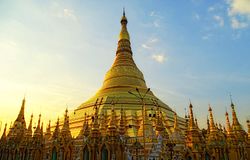
Back البوذية في ميانمار Arabic بودیسم در میانمار Persian Bouddhisme en Birmanie French Buddhizmus Burmában Hungarian Buddhisme di Myanmar ID Buddismo in Birmania Italian ミャンマーの仏教 Japanese ព្រះពុទ្ធសាសនានៅភូមា Cambodian 미얀마의 불교 Korean म्यानमारमधील बौद्ध धर्म Marathi
 သာသနာ့အလံတော် Flag of Sāsana | |
 | |
| Total population | |
|---|---|
| c. 48 million (90%) in 2016[1] | |
| Regions with significant populations | |
| Throughout Myanmar | |
| Religions | |
| Languages | |
| Burmese and other languages |
| Part of a series on |
| Theravāda Buddhism |
|---|
 |
| Buddhism |

Buddhism (Burmese: ဗုဒ္ဓဘာသာ), specifically Theravāda Buddhism (Burmese: ထေရဝါဒဗုဒ္ဓဘာသာ), is the official and state religion of Myanmar since 1961,[2] and practiced by nearly 90% of the population.[3][4] It is the most religious Buddhist country in terms of the proportion of monks in the population and proportion of income spent on religion.[5] Adherents are most likely found among the dominant Bamar people, Shan, Rakhine, Mon, Karen, and Chinese who are well integrated into Burmese society. Monks, collectively known as the sangha (community), are venerated members of Burmese society. Among many ethnic groups in Myanmar, including the Bamar and Shan, Theravada Buddhism is practiced in conjunction with the worship of nats, which are spirits who can intercede in worldly affairs.
Regarding the practice of Buddhism, two popular practices stand out: merit-making and vipassanā meditation. There is also the less popular weizza path.[6] Merit-making is the most common path undertaken by Burmese Buddhists. This path involves the observance of the Five precepts and accumulation of good merit through charity (dana, often to monks) and good deeds to obtain a favorable rebirth. The meditation path, which has gained ground since the early 1900s, is a form of Buddhist meditation which is seen as leading to awakening and can involve intense meditation retreats. The weizza path is an esoteric system of occult practices (such as recitation of spells, samatha and alchemy) believed to lead to life as a weizza (Burmese: ဝိဇ္ဇာ Pali: vijjā), a semi-immortal and supernatural being who awaits the appearance of the future Buddha, Maitreya (Arimeitaya).[7]
- ^ Department of Population Ministry of Labour, Immigration and Population MYANMAR (July 2016). The 2014 Myanmar Population and Housing Census Census Report Volume 2-C. Department of Population Ministry of Labour, Immigration and Population MYANMAR. pp. 12–15. Archived from the original on 27 April 2020. Retrieved 24 May 2020.
- ^ "၁၉၆၁ ခုနှစ်၊ နိုင်ငံတော်ဘာသာသာသနာချီးမြှောက်ထောက်ပံ့ရေးအက်ဥပဒေ" [1961 year, State Religion Promotion and Support Act]. Constitutional Tribunal of the Union, Law Library. Archived from the original on 25 October 2022. Retrieved 21 March 2022.
တည်ဆဲဥပဒေဖြစ်ပါသည် [It is an existing law]
- ^ "The World Factbook". 4 October 2022. Archived from the original on 10 February 2021. Retrieved 24 January 2021.
- ^ "Burma—International Religious Freedom Report 2009". U.S. Department of State. 26 October 2009. Archived from the original on 30 November 2009. Retrieved 11 November 2009.
- ^ Cone & Gombrich, Perfect Generosity of Prince Vessantara, Oxford University Press, 1977, page xxii
- ^ Pranke, Patrick A (2013), Myanmar, Encyclopedia of Buddhism, Macmillan Reference USA., ISBN 978-0-02-865718-9
- ^ Ferguson, John P.; E. Michael Mendelson (1981). Masters of the Buddhist Occult: The Burmese Weikzas. Essays on Burma. Brill Archive. pp. 62–4. ISBN 978-90-04-06323-5.